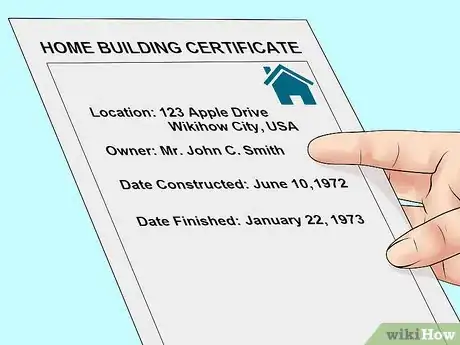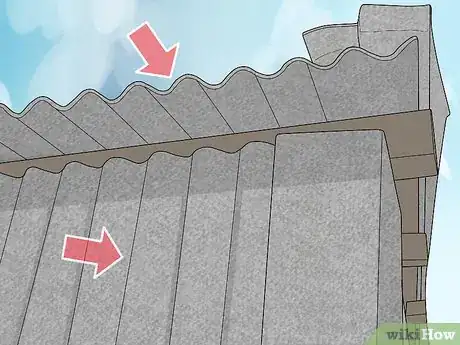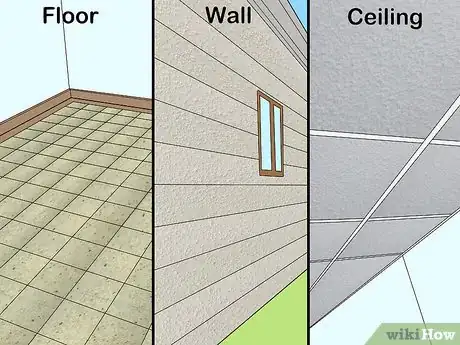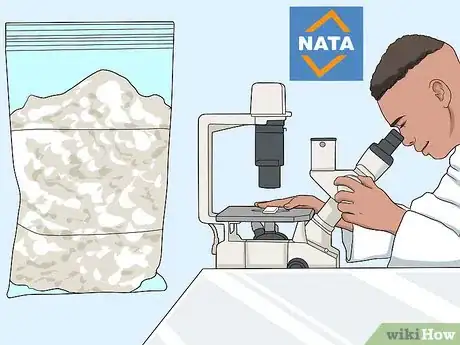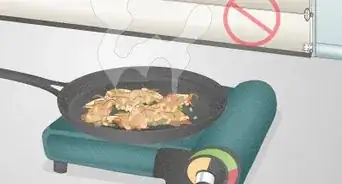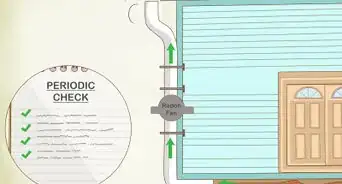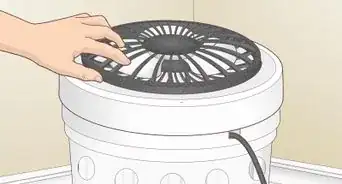This article was co-authored by Gregory Cade, JD. Gregory Cade is an Environmental and Occupational Law Attorney. With over 25 years of experience, he has extensive knowledge in injuries resulting from toxic substance exposure like pesticides. He is a member of numerous professional organizations, including The American Bar Association, The National Association of Environmental Professionals, and The American Association for Justice. Gregory graduated with a BS in Natural Science and Mathematics with an emphasis in Chemistry and Biology and an MPH in Occupational Health, Safety, and Industrial Hygiene from The University of Alabama at Birmingham. He also holds a JD from Miles School of Law.
This article has been viewed 210,862 times.
Before the dangers of asbestos were common knowledge, it was widely used as a building material in residential and commercial buildings. Even though the health risks of asbestos fibers are now known, many structures built with the material still stand. Asbestos is made of microscopic fibers that cannot be seen by the naked eye. In order to identify it, you need to know what materials investigate, look for any manufacturer labels, and consult experts when in doubt.
Steps
Identifying Possible Asbestos Materials
-
1Date the material. Check the manufacturer and product name on the insulation label and do a web search to find out if it contains asbestos.[1] The date of the building or material can also tell you a lot about asbestos risk. Buildings made between the 1940s and the 1980s are very likely to have used asbestos materials. Even still, asbestos was phased out in the 1980s, so some buildings built during that time could have still used asbestos materials. If the building was built after 1995, it almost certainly utilized no asbestos materials.
-
2Look at joints. On the outside of buildings, asbestos sheets were often joined together with aluminum runners. These runners were held on by small nails with no point at the end. On the inside, asbestos sheets were held together with plastic or wooden runners in the same way. This design could be a sign that the structure was built using asbestos materials. You should also inspect any adhesives used to join two materials together, as they often contain asbestos.Advertisement
-
3Analyze surface patterns. Asbestos materials often have a pattern on the surface that looks like small dimples or shallow craters covering the surface. Later materials have a smoother texture. While this is not a foolproof identification, seeing a dimpled pattern on the surface warrants taking asbestos precautions.
-
4Inspect exterior building materials. Asbestos was used to make several exterior materials. Roofing and siding shingles are among the most common materials to contain asbestos, and will readily release fibers into the air if broken. Asbestos was also put into cement used on the exterior of buildings to help insulate the.
- Most older cement board products contain asbestos. This type of material looks like a thin piece of concrete with fibers running through it and was frequently used as siding, corrugated roofing, and soffit material.
-
5Investigate interior panels. Floors, walls, and ceilings were often made with asbestos containing materials.[2] Watch for an oily appearance to floor tiles, which indicates that they are made from asbestos bound with asphalt. Vinyl tiles and decorative wall plasters commonly contain asbestos.
- Blow-in asbestos was also frequently used for ceiling tiles and in ceilings above drywall before it was known to be dangerous. This type of asbestos looks gray or off-white with fibers in it.
-
6Check appliances and finishing materials. Aside from common construction materials, asbestos was used in a number of other manufactured pieces.[3] These materials can be found in any system in your home or building. Some examples include:[4]
- Insulation
- Duct Work
- Flues
- Cowls
- Fireproof Materials (doors, cabinets, etc.)
- Eaves
- Carpet Underlay
- Caulking and sealers
- Window putty
- Pipes (looks like several layers of paper wrapped around the pipe)
-
7Assess the location. Asbestos is a very strong, durable material. It is not susceptible to water the way that many materials are. For that reason, asbestos materials were often used in places like bathrooms and basements to avoid dealing with water damages.
Looking for Identification Markers
-
1Identify the mold. Asbestos was molded into many different shapes and sizes to fill different needs. For example, sheets of asbestos were used to make up walls, and slats of asbestos were created to serve as roof tiles. Each mold has a different location that may be stamped with manufacturer’s information. This information sometimes discloses whether or not the material contains asbestos.
-
2Scan for letter codes. Once you’ve identified the mold, look for any information that the manufacturer stamped or printed. If you find it, look for codes such as AC (contains asbestos) or NT (does not contain asbestos). Note that not all pieces will have this information.
-
3Find additional codes. Some manufacturers used different codes at different times. If you can find any codes or markings on the material, try to look it up. Sometimes you can find the meaning of the code and determine asbestos content. Other times, information about the code is not made available.
Getting an Expert Analysis
-
1Consult someone experienced in identifying asbestos. If you are in question, assume that the material is asbestos. If you need to be sure, bring in a consultant that is uniquely qualified to identify asbestos.[5] This could be an experienced contractor or someone like a building inspector. These contacts can be found on the internet.[6]
-
2Have a professional collect a sample. Don't attempt to take a sample on your own as you could expose yourself and others in the area to asbestos. Get a qualified professional to take the sample as they will have the necessary personal protective equipment and tools to do the job.[7] For instance, they may need to put on coveralls, gloves, and a respirator before chipping off a piece of the material and putting it in a sealed container. They can use a high-efficiency particulate air (HEPA) vacuum to contain dust particles and clean the area. [8]
- The professional will also dispose of their equipment and the waste from the HEPA vacuum as per your area's regulations.
- Lab tests can tell you with certainty whether a material contains asbestos or not.
-
3Send the sample to a verified lab. Take your sample to a NATA certified lab. If there is one in your area, you can drive it there. If you have to send it off in the mail, follow any regulatory guidelines for mailing asbestos. The lab will identify the material and report back to you.[9]
Expert Q&A
-
QuestionWhat is the fastest way to test for asbestos?
 Gregory Cade, JDGregory Cade is an Environmental and Occupational Law Attorney. With over 25 years of experience, he has extensive knowledge in injuries resulting from toxic substance exposure like pesticides. He is a member of numerous professional organizations, including The American Bar Association, The National Association of Environmental Professionals, and The American Association for Justice. Gregory graduated with a BS in Natural Science and Mathematics with an emphasis in Chemistry and Biology and an MPH in Occupational Health, Safety, and Industrial Hygiene from The University of Alabama at Birmingham. He also holds a JD from Miles School of Law.
Gregory Cade, JDGregory Cade is an Environmental and Occupational Law Attorney. With over 25 years of experience, he has extensive knowledge in injuries resulting from toxic substance exposure like pesticides. He is a member of numerous professional organizations, including The American Bar Association, The National Association of Environmental Professionals, and The American Association for Justice. Gregory graduated with a BS in Natural Science and Mathematics with an emphasis in Chemistry and Biology and an MPH in Occupational Health, Safety, and Industrial Hygiene from The University of Alabama at Birmingham. He also holds a JD from Miles School of Law.
Environmental & Occupational Law Attorney If you have doubts over a product in your home potentially containing asbestos, the safest decision you can make is to send a material sample to be tested at an authorized asbestos laboratory.
If you have doubts over a product in your home potentially containing asbestos, the safest decision you can make is to send a material sample to be tested at an authorized asbestos laboratory. -
QuestionIs there such a thing as an asbestos test kit?
 Gregory Cade, JDGregory Cade is an Environmental and Occupational Law Attorney. With over 25 years of experience, he has extensive knowledge in injuries resulting from toxic substance exposure like pesticides. He is a member of numerous professional organizations, including The American Bar Association, The National Association of Environmental Professionals, and The American Association for Justice. Gregory graduated with a BS in Natural Science and Mathematics with an emphasis in Chemistry and Biology and an MPH in Occupational Health, Safety, and Industrial Hygiene from The University of Alabama at Birmingham. He also holds a JD from Miles School of Law.
Gregory Cade, JDGregory Cade is an Environmental and Occupational Law Attorney. With over 25 years of experience, he has extensive knowledge in injuries resulting from toxic substance exposure like pesticides. He is a member of numerous professional organizations, including The American Bar Association, The National Association of Environmental Professionals, and The American Association for Justice. Gregory graduated with a BS in Natural Science and Mathematics with an emphasis in Chemistry and Biology and an MPH in Occupational Health, Safety, and Industrial Hygiene from The University of Alabama at Birmingham. He also holds a JD from Miles School of Law.
Environmental & Occupational Law Attorney While testing kits allow anyone to collect damaged asbestos pieces it is not a recommended practice. You must wear protective gear, secure the area, carefully follow the handling instructions, and seal the small piece of material into the labeled bag. However, asbestos particle inhalation remains a risk, therefore you should never do it on your own.
While testing kits allow anyone to collect damaged asbestos pieces it is not a recommended practice. You must wear protective gear, secure the area, carefully follow the handling instructions, and seal the small piece of material into the labeled bag. However, asbestos particle inhalation remains a risk, therefore you should never do it on your own.
Warnings
- Make sure that you take the proper precautions and wear rubber gloves, a face mask, and clothes that cover up your entire body.⧼thumbs_response⧽
- Assume any material in question contains asbestos and use appropriate precautions.[10]⧼thumbs_response⧽
References
- ↑ Gregory Cade, JD. Environmental & Occupational Law Attorney. Expert Interview. 13 October 2021.
- ↑ Gregory Cade, JD. Environmental & Occupational Law Attorney. Expert Interview. 13 October 2021.
- ↑ Gregory Cade, JD. Environmental & Occupational Law Attorney. Expert Interview. 13 October 2021.
- ↑ http://www.asbestostesting.com.au/asbestos-pictures/
- ↑ Gregory Cade, JD. Environmental & Occupational Law Attorney. Expert Interview. 13 October 2021.
- ↑ http://www.asbestos.vic.gov.au/in-the-workplace/commercial-property-owners/find-and-identify
- ↑ Gregory Cade, JD. Environmental & Occupational Law Attorney. Expert Interview. 13 October 2021.
- ↑ https://www.asbestos.vic.gov.au/in-the-workplace/taking-asbestos-samples
- ↑ http://www.asbestos.vic.gov.au/in-the-workplace/commercial-property-owners/find-and-identify
About This Article
If your building was constructed after 1995, it likely won’t contain asbestos, but if it was made between the 1940s and 1980s, there is a good chance that it does. To determine if your building has asbestos, check areas where the material was most commonly used like the roof, bathroom, and basement. Also, look around the siding, roofing, and soffit materials for small dimples or shallow craters on the surface, which are signs of asbestos. On the interior, investigate walls and ceilings for gray or off-white fibers. As you look around, take note of any codes stamped on the building materials that indicate whether they contain asbestos. For example, the code “AC” usually means it contains asbestos and “NC” means it doesn’t. In addition to building materials, check your pipes for asbestos, which will look like paper wrapped around the pipe. To learn more, including how to find an expert to analyze your building materials for asbestos, read on.
